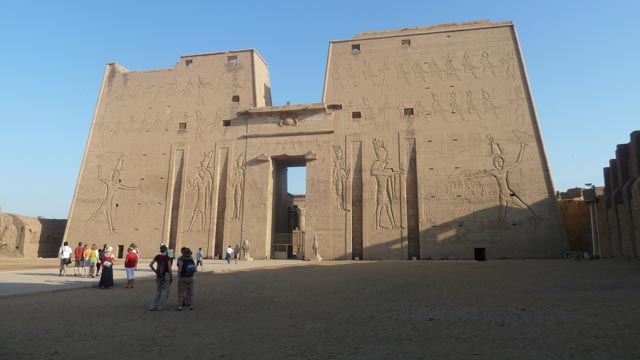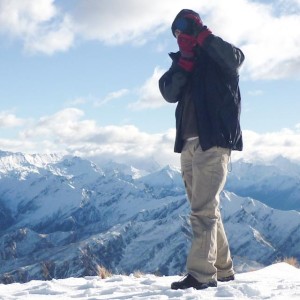This is second post about the Temple of Horus at Edfu. I guess the travelling to the Temple by Horse and 2-wheeled carriage was a different way of getting to our destination and something that was not listed on our itinerary. It was a real experience. Had some good aspects – but there were some down sides to this.
Edfu Temple – What to See
There is much to see at Edfu Temple. You need a reasonable amount of time to see the Temple properly. Being on a cruise, our time limit was capped and there were many people there at the same time. When we visited the Temple, we started with a lesson from our Egyptian Guide about the structure of Temples, the series of Courts and their purpose.
Our group had some diagrams drawn in the dirt, which gave us a great insight on being able to appreciate the Egyptian Mythology and the impact it has had on the pharaohs over the years.
I found that the Edfu Temple was about the best-preserved temple of all we visited whilst in Egypt.

When facing the Pylon from the south, which is from the car park area, there is the Birth House on the left. This colonnaded structure was the site of the annual Festival of Coronation, which reenacted the divine birth of Horus and the reigning pharaoh.

The Pylon was one of the last features to be added. Standing 37m high, it is among the largest in Egypt. Its reliefs show a later Ptolemaic ruler smiting his enemies before Horus the Elder.
Court of Offerings
Beyond the Pylon is the spacious Court of Offerings, where people could enter to make offerings to the image of Horus. The court is surrounded by columns on three sides and is decorated with festival reliefs.
Beneath the western colonnade are reliefs of Ptolemy IX making offerings to Horus, Hathor and Ihy.
Horus statues
At the back of the Court of Offerings, outside the Hypostyle Hall, are a pair of black granite Horus statues. One stands taller than a man and is a favorite photographic subject.

Hypostyle Hall
The rectangular Hypostyle Hall was built under Ptolemy VII (145-116 BC) and has two rows of six pillars supporting an intact roof. The ceiling has astronomical paintings symbolizing the sky.
Festival Hall
Next is the Festival Hall, which marks the beginning of the oldest part of the temple, built 237-212 BC under Ptolemy III and IV.
A small doorway, decorated with splendid reliefs of the sacred barques of Horus and Hathor, leads from the Festival Hall into the Hall of Offerings.

This hall leads into the Sanctuary of Horus, the holiest part of the temple. The sanctuary centers on a black-granite shrine that was dedicated by Nectanebo II, making it the oldest relic in the temple. This once contained the gilded wooden cult image of Horus. Next to the shrine is an offering table and the ceremonial barque (barge) on which Horus was carried during festivals. Reliefs on the right (east) wall of the sanctuary show Philopator (Ptolemy IV) worshipping Horus, Hathor and his deified parents in the sanctuary.
For more information about Edfu Temple
- 2014-03-19 – Esna – Kom Ombo – Aswan
- Edfu Temple – Part 2
- Edfu Temple – Part 3
- Edfu Temple – Part 1
- Egyptian Mythology – Horus
